Home / The Cope Elimination
Amines
The Cope Elimination
Last updated: August 27th, 2025 |
Cope Elimination
The “Cope Elimination” is a reaction where an amine is oxidized to an intermediate called an “N-oxide“, which, when heated, acts as the base in an intramolecular elimination reaction to give a new alkene.
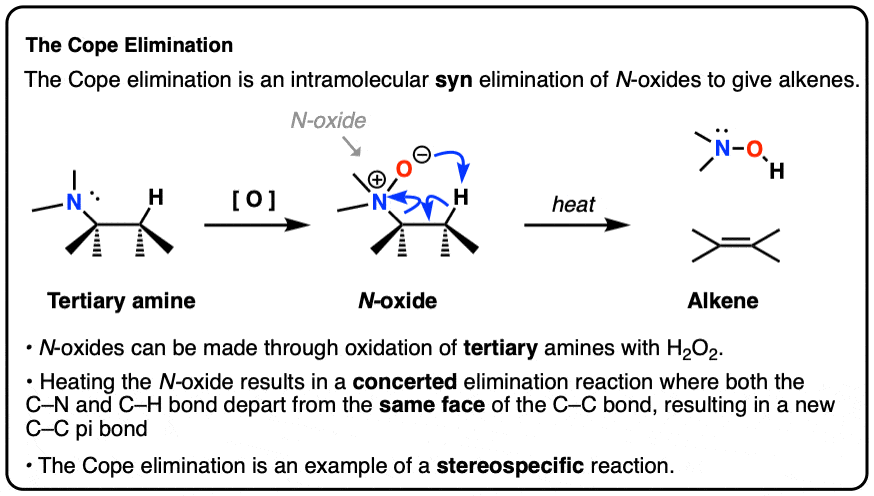
Table of Contents
- The Cope Elimination, Part One: Formation Of The N-Oxide
- The Cope Elimination, Part Two: Heating Induces An Intramolecular Elimination Reaction
- The Cope Elimination vs. The “E2” Elimination: Stereochemistry
- The Cope Elimination: Mechanism
- Summary: The Cope Elimination
- Notes
- Quiz Yourself!
- (Advanced) References and Further Reading
1. The Cope Elimination, Part One: Formation Of The N-Oxide
The Cope Elimination starts with formation of a species called an “N-oxide”. Treating a tertiary amine (which itself can be created through reductive amination, for instance) with hydrogen peroxide and base results in an “N-oxide”, which has a positive charge on nitrogen and a negative charge on oxygen:
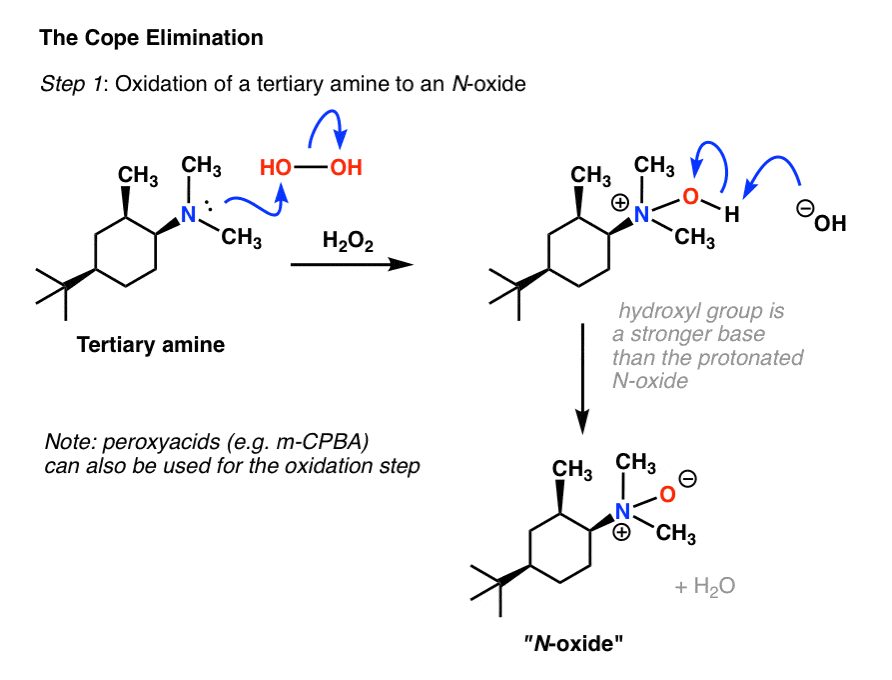
In the first part of this process, the amine attacks hydrogen peroxide (or the OH of a peroxyacid, such as m-CPBA), forming N-OH and breaking the weak O-O bond. The amine oxide O-H bond is then deprotonated by the strong hydroxide base, resulting in formation of the N-oxide.
(Note that there are opposite charges on adjacent atoms in the N-oxide; it is a “zwitterion”. Also, the starting amine must be tertiary for this process – using a secondary or primary amine will lead down other reaction pathways that we need not concern ourselves with here)
2. The Cope Elimination, Part Two: Heating Induces An Intramolecular Elimination Reaction
The O– in N-oxides is a weak base (pKaH = 4.5 about as strong as pyridine). When heated sufficiently [e.g. 160°C], an elimination reaction occurs, leading to the formation of an alkene, along with a substituted hydroxylamine:
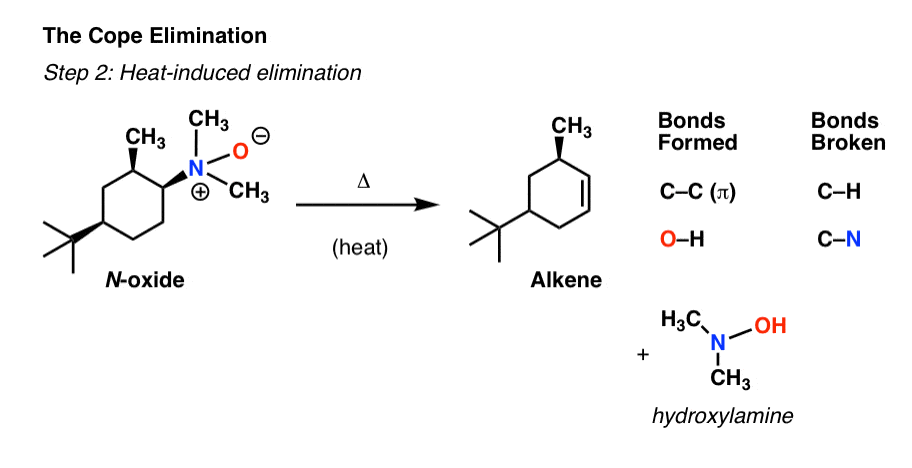
3. The Cope Elimination vs. The “E2” Elimination: Stereochemistry
The Cope Elimination differs from the familiar E2 elimination mechanism in several important ways.
First, stereochemistry.
- The E2 always proceeds such that the two sigma bonds that break [the C-H bond and the C-LG (leaving group) bond] are oriented anti to each other (dihedral angle of 180°, like the hour-hand and minute-hand of a clock at 6:00)
- In the Cope elimination, the breaking C-H bond and the breaking C-N bond are oriented syn to each other (dihedral angle of 0°, like the hour-hand and minute-hand of a clock at midnight).
Secondly, the E2 is almost always [Note 1] an intermolecular process, where the rate depends both on the concentration of the substrate and the concentration of the base.
The Cope is an intramolecular elimination reaction, which is to say that the base (the N-oxide) and the acid (the C-H bond) are always contained within the same molecule.
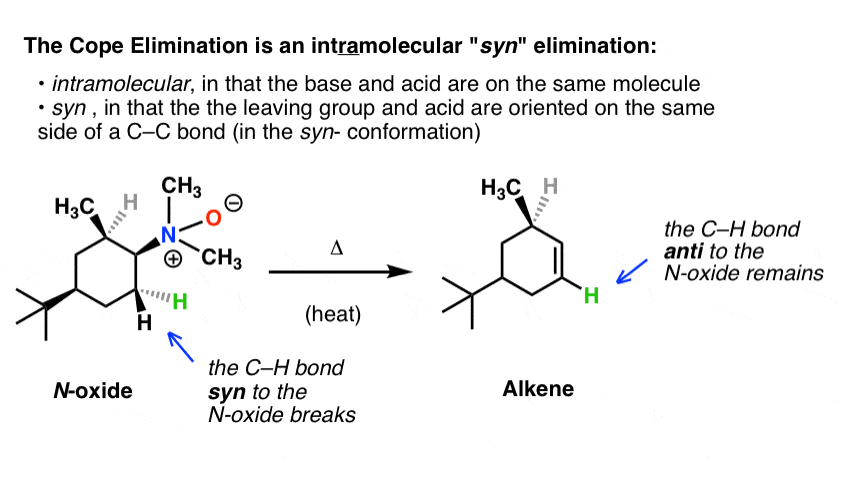
Note how the proton marked in green remains in the Cope elimination (above) but is lost in the E2 (below):
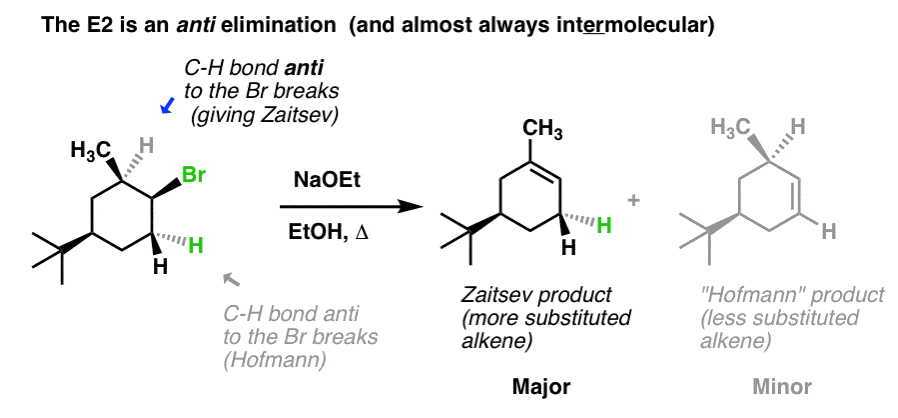
So how does it work?
4. The Cope Elimination: Mechanism
The Cope proceeds through a concerted syn-elimination mechanism. The oxygen from the N-oxide acts a base, forming an O-H bond, while the C-H and C-N bonds break to form the new C-C pi bond:
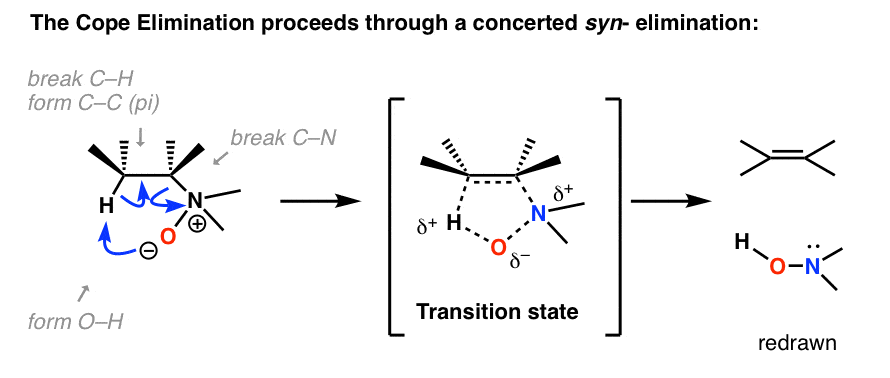
Here’s how it would look in the example we’ve been working with:
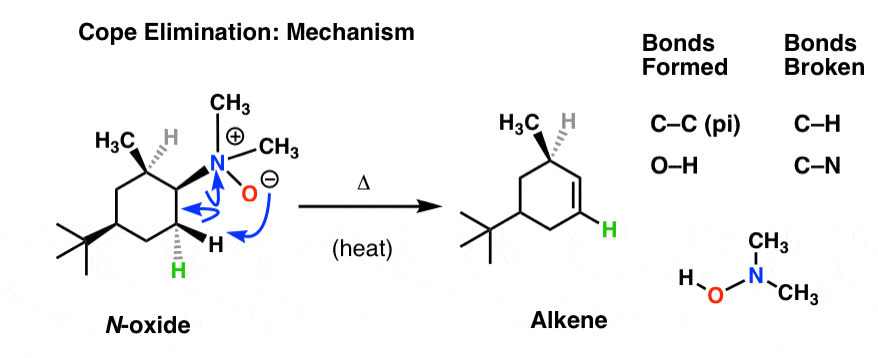
5. Summary: The Cope Elimination
The Cope rearrangement is an intramolecular, syn-selective elimination reaction that converts a tertiary amine to an alkene.
Why might one use the Cope elimination instead of a traditional elimination like the E2 ? Well, sometimes it’s much easier to perform an elimination reaction when the base is literally next-door (i.e. an intramolecular process) as opposed to heating an alkyl halide with a strong base. This especially has an advantage in situations where many side reactions can occur or the base cannot readily access the desired C-H bond due to steric hindrance [Note 2] .
Being a concerted, six-electron process, the Cope is also a member of the family of sigmatropic reactions which includes the Diels-Alder, the Claisen rearrangement, the Cope rearrangement (different reaction, same Cope!) and many others.
Notes
What About Zaitsev’s Rule?
The Hofmann elimination of ammonium salts tends to give the less substituted alkene [see: The Hofmann Elimination ].
So what about the Cope elimination? It’s got a bulky leaving group too, after all. Does it undergo elimination to give the less substituted alkene, just like in the Hofmann?
My apologies, but I’m going to go all “Choose Your Own Adventure” on this.
Click on the answer you want to hear:
Yes, the Cope Elimination Gives The Hofmann Products (link to image)
(In short: for reasons beyond the scope of our discussion there’s contradictory evidence, and for now, if you are led to believe that it undergoes Hofmann elimination, that’s probably OK unless you take advanced level studies in organic chemistry).
Related Articles
Note 1. “almost always”, because it’s possible to come up with examples of molecules that, once deprotonated, perform anti-selective elimination reactions that are formally an intramolecular process – a rare exception.
Note 2. As it turns out, the Cope is just one member of a fairly large family of syn-selective intramolecular elimination reactions, involving selenium, sulfur, and other atoms.
Note 3. An example of the Cope Elimination in action – this one required heating to 160°C.
Note 4. Interesting table, from the Organic Reactions review on the Cope Elimination: the phenethyl group (Ph-CH2-CH2–) is by far (>100) faster to eliminate than any other alkyl group. Probably a combination of being a more acidic proton and also assistance from conjugation with the aromatic ring.
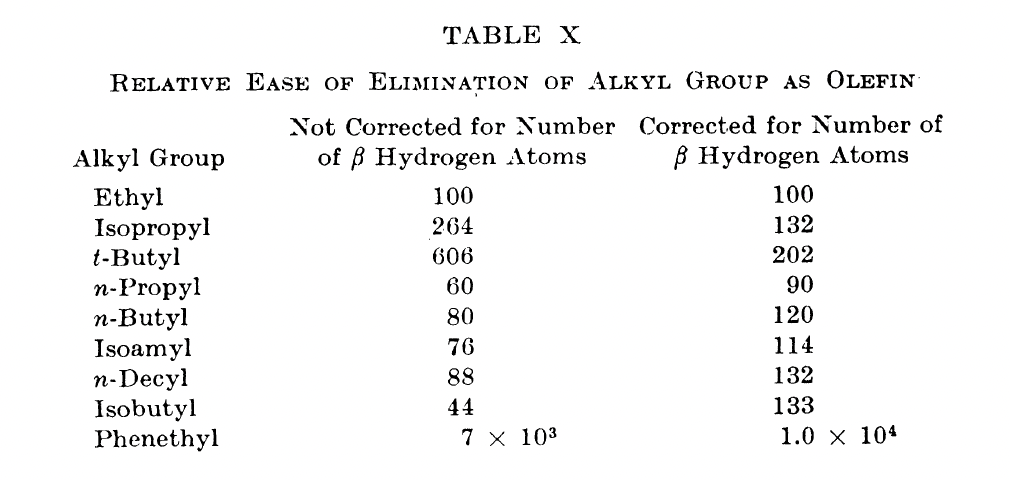
Quiz Yourself!
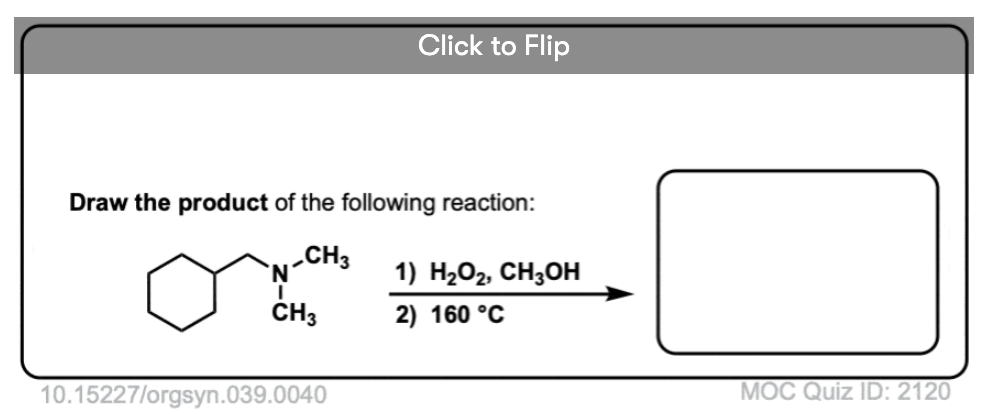
Become a MOC member to see the clickable quiz with answers on the back.
<p class=”p1″><img class=”alignnone wp-image-26714″ src=”https://www.masterorganicchemistry.com/wp-content/uploads/2025/08/3337-Front-Image-Only.png” alt=”” width=”640″ height=”616″ /></p>
<a href=”https://www.masterorganicchemistry.com/moc-membership/”><strong>Become a MOC member</strong></a> to see the clickable quiz with answers on the back.
<p class=”p1″><img class=”alignnone wp-image-26714″ src=”https://www.masterorganicchemistry.com/wp-content/uploads/2025/08/3338-Front-Image-Only.png” alt=”” width=”640″ height=”616″ /></p>
<a href=”https://www.masterorganicchemistry.com/moc-membership/”><strong>Become a MOC member</strong></a> to see the clickable quiz with answers on the back.
<p class=”p1″><img class=”alignnone wp-image-26714″ src=”https://www.masterorganicchemistry.com/wp-content/uploads/2025/08/3339-Front-Image-Only.png” alt=”” width=”640″ height=”616″ /></p>
<a href=”https://www.masterorganicchemistry.com/moc-membership/”><strong>Become a MOC member</strong></a> to see the clickable quiz with answers on the back.
<p class=”p1″><img class=”alignnone wp-image-26714″ src=”https://www.masterorganicchemistry.com/wp-content/uploads/2025/08/3340-Front-Image-Only.png” alt=”” width=”640″ height=”616″ /></p>
<a href=”https://www.masterorganicchemistry.com/moc-membership/”><strong>Become a MOC member</strong></a> to see the clickable quiz with answers on the back.
<p class=”p1″><img class=”alignnone wp-image-26714″ src=”https://www.masterorganicchemistry.com/wp-content/uploads/2025/08/3341-Front-Image-Only.png” alt=”” width=”640″ height=”616″ /></p>
<a href=”https://www.masterorganicchemistry.com/moc-membership/”><strong>Become a MOC member</strong></a> to see the clickable quiz with answers on the back.
(Advanced) References and Further Reading
The Cope Elimination is a thermal syn elimination; they are thermally activated, unimolecular, require no acid/base catalysis, and because the intramolecular hydrogen transfer is concerted with the formation of the C=C double bond, this reaction proceed via a cyclic transition state. The cyclic transition state also dictates that the elimination occur with syn stereochemistry.
A great reference is Organic Reactions which covers the discovery of this reaction and every example of it up until 1960. Link.
- Zur Einwirkung von Wasserstoffsuperoxyd auf Fettamine
Mamlock R. Wolffenstein
Chem. Ber. 1900, 33 (1), 159-161
DOI: 10.1002/cber.19000330120
The thermolysis of a tertiary amine N-oxide to give an olefin and an N,N-disubstituted hydroxylamine was first described by Mamlock and Wolffenstein in this paper at the turn of the century, but the reaction remained unused until Cope and co-workers, starting in 1947, explored the scope and mechanism of this alternative to the Hofmann elimination reaction for the conversion of tertiary amines into olefins. - METHYLENECYCLOHEXANE AND N,N-DIMETHYLHYDROXYLAMINE HYDROCHLORIDE
Arthur C. Cope and Engelbert Ciganek
Org. Synth. 1959, 39, 40
DOI: 10.15227/orgsyn.039.0040
An Organic Syntheses prep by Prof. Cope himself demonstrating the utility in this reaction in forming exocyclic double bonds, as an alternative to Wittig chemistry. Additionally, as Prof. Cope mentions in the notes, “This route from amines to olefins in many cases yields pure olefins where the alternative method, the Hofmann exhaustive methylation reaction, is accompanied by some rearrangement to more stable isomeric olefins.” - Amine Oxides. VIII. Medium-sized Cyclic Olefins from Amine Oxides and Quaternary Ammonium Hydroxides
Arthur C. Cope, Engelbert Ciganek, Charles F. Howell, and Edward E. Schweizer
Journal of the American Chemical Society 1960, 82 (17), 4663-4669
DOI: 10.1021/ja01502a053
This paper has illustrations of the cyclic transition state of this reaction, which is what the authors propose as the mechanism to rationalize the observed syn - Room Temperature Wolff-Kishner Reduction and Cope Elimination Reactions
Donald J. Cram, Melville R. V. Sahyun, and Graham R. Knox
Journal of the American Chemical Society 1962, 84 (9), 1734-1735
DOI: 10.1021/ja00868a048
This paper by Prof. D. J. Cram (UCLA), who later received the Nobel Prize in Chemistry for his contributions to supramolecular chemistry, shows that dry THF or DMSO can be used as solvents for the Cope Elimination. In these solvents, elimination occurs at room temperature! - Mechanism of the Cope elimination
Robert D. Bach, Denis Andrzejewski, and Laurence R. Dusold
The Journal of Organic Chemistry 1973, 38 (9), 1742-1743
DOI: 10.1021/jo00949a029
In the words of this paper, it “report[s] unequivocal deuterium-labeling evidence that establishes the mechanism of the Cope elimination as a 100% syn elimination”. - Reverse Cope elimination reactions. 1. Mechanism and scope
Engelbert Ciganek, John M. Read Jr., and Joseph C. Calabrese
The Journal of Organic Chemistry 1995, 60 (18), 5795-5802
DOI: 10.1021/jo00123a013
Reverse Cope Eliminations are also possible. This is the formation of a tertiary amine-N-oxide from an olefin and an N,N-disubstituted hydroxylamine.
00 General Chemistry Review
01 Bonding, Structure, and Resonance
- How Do We Know Methane (CH4) Is Tetrahedral?
- Hybrid Orbitals and Hybridization
- How To Determine Hybridization: A Shortcut
- Orbital Hybridization And Bond Strengths
- Sigma bonds come in six varieties: Pi bonds come in one
- Dipole Moments and Dipoles
- A Key Skill: How to Calculate Formal Charge
- The Four Intermolecular Forces and How They Affect Boiling Points
- 3 Trends That Affect Boiling Points
- How To Use Electronegativity To Determine Electron Density (and why NOT to trust formal charge)
- Introduction to Resonance
- How To Use Curved Arrows To Interchange Resonance Forms
- Evaluating Resonance Forms (1) - The Rule of Least Charges
- How To Find The Best Resonance Structure By Applying Electronegativity
- Evaluating Resonance Structures With Negative Charges
- Evaluating Resonance Structures With Positive Charge
- Exploring Resonance: Pi-Donation
- Exploring Resonance: Pi-acceptors
- In Summary: Evaluating Resonance Structures
- Drawing Resonance Structures: 3 Common Mistakes To Avoid
- How to apply electronegativity and resonance to understand reactivity
- Bond Hybridization Practice
- Structure and Bonding Practice Quizzes
- Resonance Structures Practice
02 Acid Base Reactions
- Introduction to Acid-Base Reactions
- Acid Base Reactions In Organic Chemistry
- The Stronger The Acid, The Weaker The Conjugate Base
- Walkthrough of Acid-Base Reactions (3) - Acidity Trends
- Five Key Factors That Influence Acidity
- Acid-Base Reactions: Introducing Ka and pKa
- How to Use a pKa Table
- The pKa Table Is Your Friend
- A Handy Rule of Thumb for Acid-Base Reactions
- Acid Base Reactions Are Fast
- pKa Values Span 60 Orders Of Magnitude
- How Protonation and Deprotonation Affect Reactivity
- Acid Base Practice Problems
03 Alkanes and Nomenclature
- Meet the (Most Important) Functional Groups
- Condensed Formulas: Deciphering What the Brackets Mean
- Hidden Hydrogens, Hidden Lone Pairs, Hidden Counterions
- Don't Be Futyl, Learn The Butyls
- Primary, Secondary, Tertiary, Quaternary In Organic Chemistry
- Branching, and Its Affect On Melting and Boiling Points
- The Many, Many Ways of Drawing Butane
- Wedge And Dash Convention For Tetrahedral Carbon
- Common Mistakes in Organic Chemistry: Pentavalent Carbon
- Table of Functional Group Priorities for Nomenclature
- Summary Sheet - Alkane Nomenclature
- Organic Chemistry IUPAC Nomenclature Demystified With A Simple Puzzle Piece Approach
- Boiling Point Quizzes
- Organic Chemistry Nomenclature Quizzes
04 Conformations and Cycloalkanes
- Staggered vs Eclipsed Conformations of Ethane
- Conformational Isomers of Propane
- Newman Projection of Butane (and Gauche Conformation)
- Introduction to Cycloalkanes
- Geometric Isomers In Small Rings: Cis And Trans Cycloalkanes
- Calculation of Ring Strain In Cycloalkanes
- Cycloalkanes - Ring Strain In Cyclopropane And Cyclobutane
- Cyclohexane Conformations
- Cyclohexane Chair Conformation: An Aerial Tour
- How To Draw The Cyclohexane Chair Conformation
- The Cyclohexane Chair Flip
- The Cyclohexane Chair Flip - Energy Diagram
- Substituted Cyclohexanes - Axial vs Equatorial
- Ranking The Bulkiness Of Substituents On Cyclohexanes: "A-Values"
- Cyclohexane Chair Conformation Stability: Which One Is Lower Energy?
- Fused Rings - Cis-Decalin and Trans-Decalin
- Naming Bicyclic Compounds - Fused, Bridged, and Spiro
- Bredt's Rule (And Summary of Cycloalkanes)
- Newman Projection Practice
- Cycloalkanes Practice Problems
05 A Primer On Organic Reactions
- The Most Important Question To Ask When Learning a New Reaction
- Curved Arrows (for reactions)
- Nucleophiles and Electrophiles
- The Three Classes of Nucleophiles
- Nucleophilicity vs. Basicity
- What Makes A Good Nucleophile?
- What Makes A Good Leaving Group?
- 3 Factors That Stabilize Carbocations
- Equilibrium and Energy Relationships
- 7 Factors that stabilize negative charge in organic chemistry
- 7 Factors That Stabilize Positive Charge in Organic Chemistry
- What's a Transition State?
- Hammond's Postulate
- Learning Organic Chemistry Reactions: A Checklist (PDF)
06 Free Radical Reactions
- Free Radical Reactions
- 3 Factors That Stabilize Free Radicals
- Bond Strengths And Radical Stability
- Free Radical Initiation: Why Is "Light" Or "Heat" Required?
- Initiation, Propagation, Termination
- Monochlorination Products Of Propane, Pentane, And Other Alkanes
- Selectivity In Free Radical Reactions
- Selectivity in Free Radical Reactions: Bromination vs. Chlorination
- Halogenation At Tiffany's
- Allylic Bromination
- Bonus Topic: Allylic Rearrangements
- In Summary: Free Radicals
- Synthesis (2) - Reactions of Alkanes
- Free Radicals Practice Quizzes
07 Stereochemistry and Chirality
- Types of Isomers: Constitutional Isomers, Stereoisomers, Enantiomers, and Diastereomers
- How To Draw The Enantiomer Of A Chiral Molecule
- How To Draw A Bond Rotation
- Introduction to Assigning (R) and (S): The Cahn-Ingold-Prelog Rules
- Assigning Cahn-Ingold-Prelog (CIP) Priorities (2) - The Method of Dots
- Enantiomers vs Diastereomers vs The Same? Two Methods For Solving Problems
- Assigning R/S To Newman Projections (And Converting Newman To Line Diagrams)
- How To Determine R and S Configurations On A Fischer Projection
- The Meso Trap
- Optical Rotation, Optical Activity, and Specific Rotation
- Optical Purity and Enantiomeric Excess
- What's a Racemic Mixture?
- Chiral Allenes And Chiral Axes
- Stereochemistry Practice Problems and Quizzes
08 Substitution Reactions
- Nucleophilic Substitution Reactions - Introduction
- Two Types of Nucleophilic Substitution Reactions
- The SN2 Mechanism
- Why the SN2 Reaction Is Powerful
- The SN1 Mechanism
- The Conjugate Acid Is A Better Leaving Group
- Comparing the SN1 and SN2 Reactions
- Polar Protic? Polar Aprotic? Nonpolar? All About Solvents
- Steric Hindrance is Like a Fat Goalie
- Common Blind Spot: Intramolecular Reactions
- Substitution Practice - SN1
- Substitution Practice - SN2
09 Elimination Reactions
- Elimination Reactions (1): Introduction And The Key Pattern
- Elimination Reactions (2): The Zaitsev Rule
- Elimination Reactions Are Favored By Heat
- Two Elimination Reaction Patterns
- The E1 Reaction
- The E2 Mechanism
- E1 vs E2: Comparing the E1 and E2 Reactions
- Antiperiplanar Relationships: The E2 Reaction and Cyclohexane Rings
- Bulky Bases in Elimination Reactions
- Comparing the E1 vs SN1 Reactions
- Elimination (E1) Reactions With Rearrangements
- E1cB - Elimination (Unimolecular) Conjugate Base
- Elimination (E1) Practice Problems And Solutions
- Elimination (E2) Practice Problems and Solutions
10 Rearrangements
11 SN1/SN2/E1/E2 Decision
- Identifying Where Substitution and Elimination Reactions Happen
- Deciding SN1/SN2/E1/E2 (1) - The Substrate
- Deciding SN1/SN2/E1/E2 (2) - The Nucleophile/Base
- SN1 vs E1 and SN2 vs E2 : The Temperature
- Deciding SN1/SN2/E1/E2 - The Solvent
- Wrapup: The Key Factors For Determining SN1/SN2/E1/E2
- Alkyl Halide Reaction Map And Summary
- SN1 SN2 E1 E2 Practice Problems
12 Alkene Reactions
- E and Z Notation For Alkenes (+ Cis/Trans)
- Alkene Stability
- Alkene Addition Reactions: "Regioselectivity" and "Stereoselectivity" (Syn/Anti)
- Stereoselective and Stereospecific Reactions
- Hydrohalogenation of Alkenes and Markovnikov's Rule
- Hydration of Alkenes With Aqueous Acid
- Rearrangements in Alkene Addition Reactions
- Halogenation of Alkenes and Halohydrin Formation
- Oxymercuration Demercuration of Alkenes
- Hydroboration Oxidation of Alkenes
- m-CPBA (meta-chloroperoxybenzoic acid)
- OsO4 (Osmium Tetroxide) for Dihydroxylation of Alkenes
- Palladium on Carbon (Pd/C) for Catalytic Hydrogenation of Alkenes
- Cyclopropanation of Alkenes
- A Fourth Alkene Addition Pattern - Free Radical Addition
- Alkene Reactions: Ozonolysis
- Oxidative Cleavage of Vicinal Diols With NaIO4 and Pb(OAc)4
- Summary: Three Key Families Of Alkene Reaction Mechanisms
- Synthesis (4) - Alkene Reaction Map, Including Alkyl Halide Reactions
- Alkene Reactions Practice Problems
13 Alkyne Reactions
- Acetylides from Alkynes, And Substitution Reactions of Acetylides
- Partial Reduction of Alkynes With Lindlar's Catalyst
- Partial Reduction of Alkynes With Na/NH3 To Obtain Trans Alkenes
- Alkyne Hydroboration With "R2BH"
- Hydration and Oxymercuration of Alkynes
- Hydrohalogenation of Alkynes
- Alkyne Halogenation: Bromination and Chlorination of Alkynes
- Oxidation of Alkynes With O3 and KMnO4
- Alkenes To Alkynes Via Halogenation And Elimination Reactions
- Alkynes Are A Blank Canvas
- Synthesis (5) - Reactions of Alkynes
- Alkyne Reactions Practice Problems With Answers
14 Alcohols, Epoxides and Ethers
- Alcohols - Nomenclature and Properties
- Alcohols Can Act As Acids Or Bases (And Why It Matters)
- Alcohols - Acidity and Basicity
- The Williamson Ether Synthesis
- Ethers From Alkenes, Tertiary Alkyl Halides and Alkoxymercuration
- Alcohols To Ethers via Acid Catalysis
- Cleavage Of Ethers With Acid
- Epoxides - The Outlier Of The Ether Family
- Opening of Epoxides With Acid
- Epoxide Ring Opening With Base
- Making Alkyl Halides From Alcohols
- Tosylates And Mesylates
- PBr3 and SOCl2
- Elimination Reactions of Alcohols
- Elimination of Alcohols To Alkenes With POCl3
- Alcohol Oxidation: "Strong" and "Weak" Oxidants
- Demystifying The Mechanisms of Alcohol Oxidations
- Protecting Groups For Alcohols
- Thiols And Thioethers
- Calculating the oxidation state of a carbon
- Oxidation and Reduction in Organic Chemistry
- Oxidation Ladders
- SOCl2 Mechanism For Alcohols To Alkyl Halides: SN2 versus SNi
- Alcohol Reactions Roadmap (PDF)
- Alcohol Reaction Practice Problems
- Epoxide Reaction Quizzes
- Oxidation and Reduction Practice Quizzes
15 Organometallics
- What's An Organometallic?
- Formation of Grignard and Organolithium Reagents
- Organometallics Are Strong Bases
- Reactions of Grignard Reagents
- Protecting Groups In Grignard Reactions
- Synthesis Problems Involving Grignard Reagents
- Grignard Reactions And Synthesis (2)
- Organocuprates (Gilman Reagents): How They're Made
- Gilman Reagents (Organocuprates): What They're Used For
- The Heck, Suzuki, and Olefin Metathesis Reactions (And Why They Don't Belong In Most Introductory Organic Chemistry Courses)
- Reaction Map: Reactions of Organometallics
- Grignard Practice Problems
16 Spectroscopy
- Degrees of Unsaturation (or IHD, Index of Hydrogen Deficiency)
- Conjugation And Color (+ How Bleach Works)
- Introduction To UV-Vis Spectroscopy
- UV-Vis Spectroscopy: Absorbance of Carbonyls
- UV-Vis Spectroscopy: Practice Questions
- Bond Vibrations, Infrared Spectroscopy, and the "Ball and Spring" Model
- Infrared (IR) Spectroscopy: A Quick Primer On Interpreting Spectra
- IR Spectroscopy: 4 Practice Problems
- 1H NMR: How Many Signals?
- Homotopic, Enantiotopic, Diastereotopic
- Diastereotopic Protons in 1H NMR Spectroscopy: Examples
- 13-C NMR - How Many Signals
- Liquid Gold: Pheromones In Doe Urine
- Natural Product Isolation (1) - Extraction
- Natural Product Isolation (2) - Purification Techniques, An Overview
- Structure Determination Case Study: Deer Tarsal Gland Pheromone
17 Dienes and MO Theory
- What To Expect In Organic Chemistry 2
- Are these molecules conjugated?
- Conjugation And Resonance In Organic Chemistry
- Bonding And Antibonding Pi Orbitals
- Molecular Orbitals of The Allyl Cation, Allyl Radical, and Allyl Anion
- Pi Molecular Orbitals of Butadiene
- Reactions of Dienes: 1,2 and 1,4 Addition
- Thermodynamic and Kinetic Products
- More On 1,2 and 1,4 Additions To Dienes
- s-cis and s-trans
- The Diels-Alder Reaction
- Cyclic Dienes and Dienophiles in the Diels-Alder Reaction
- Stereochemistry of the Diels-Alder Reaction
- Exo vs Endo Products In The Diels Alder: How To Tell Them Apart
- HOMO and LUMO In the Diels Alder Reaction
- Why Are Endo vs Exo Products Favored in the Diels-Alder Reaction?
- Diels-Alder Reaction: Kinetic and Thermodynamic Control
- The Retro Diels-Alder Reaction
- The Intramolecular Diels Alder Reaction
- Regiochemistry In The Diels-Alder Reaction
- The Cope and Claisen Rearrangements
- Electrocyclic Reactions
- Electrocyclic Ring Opening And Closure (2) - Six (or Eight) Pi Electrons
- Diels Alder Practice Problems
- Molecular Orbital Theory Practice
18 Aromaticity
- Introduction To Aromaticity
- Rules For Aromaticity
- Huckel's Rule: What Does 4n+2 Mean?
- Aromatic, Non-Aromatic, or Antiaromatic? Some Practice Problems
- Antiaromatic Compounds and Antiaromaticity
- The Pi Molecular Orbitals of Benzene
- The Pi Molecular Orbitals of Cyclobutadiene
- Frost Circles
- Aromaticity Practice Quizzes
19 Reactions of Aromatic Molecules
- Electrophilic Aromatic Substitution: Introduction
- Activating and Deactivating Groups In Electrophilic Aromatic Substitution
- Electrophilic Aromatic Substitution - The Mechanism
- Ortho-, Para- and Meta- Directors in Electrophilic Aromatic Substitution
- Understanding Ortho, Para, and Meta Directors
- Why are halogens ortho- para- directors?
- Disubstituted Benzenes: The Strongest Electron-Donor "Wins"
- Electrophilic Aromatic Substitutions (1) - Halogenation of Benzene
- Electrophilic Aromatic Substitutions (2) - Nitration and Sulfonation
- EAS Reactions (3) - Friedel-Crafts Acylation and Friedel-Crafts Alkylation
- Intramolecular Friedel-Crafts Reactions
- Nucleophilic Aromatic Substitution (NAS)
- Nucleophilic Aromatic Substitution (2) - The Benzyne Mechanism
- Reactions on the "Benzylic" Carbon: Bromination And Oxidation
- The Wolff-Kishner, Clemmensen, And Other Carbonyl Reductions
- More Reactions on the Aromatic Sidechain: Reduction of Nitro Groups and the Baeyer Villiger
- Aromatic Synthesis (1) - "Order Of Operations"
- Synthesis of Benzene Derivatives (2) - Polarity Reversal
- Aromatic Synthesis (3) - Sulfonyl Blocking Groups
- Birch Reduction
- Synthesis (7): Reaction Map of Benzene and Related Aromatic Compounds
- Aromatic Reactions and Synthesis Practice
- Electrophilic Aromatic Substitution Practice Problems
20 Aldehydes and Ketones
- What's The Alpha Carbon In Carbonyl Compounds?
- Nucleophilic Addition To Carbonyls
- Aldehydes and Ketones: 14 Reactions With The Same Mechanism
- Sodium Borohydride (NaBH4) Reduction of Aldehydes and Ketones
- Grignard Reagents For Addition To Aldehydes and Ketones
- Wittig Reaction
- Hydrates, Hemiacetals, and Acetals
- Imines - Properties, Formation, Reactions, and Mechanisms
- All About Enamines
- Breaking Down Carbonyl Reaction Mechanisms: Reactions of Anionic Nucleophiles (Part 2)
- Aldehydes Ketones Reaction Practice
21 Carboxylic Acid Derivatives
- Nucleophilic Acyl Substitution (With Negatively Charged Nucleophiles)
- Addition-Elimination Mechanisms With Neutral Nucleophiles (Including Acid Catalysis)
- Basic Hydrolysis of Esters - Saponification
- Transesterification
- Proton Transfer
- Fischer Esterification - Carboxylic Acid to Ester Under Acidic Conditions
- Lithium Aluminum Hydride (LiAlH4) For Reduction of Carboxylic Acid Derivatives
- LiAlH[Ot-Bu]3 For The Reduction of Acid Halides To Aldehydes
- Di-isobutyl Aluminum Hydride (DIBAL) For The Partial Reduction of Esters and Nitriles
- Amide Hydrolysis
- Thionyl Chloride (SOCl2) And Conversion of Carboxylic Acids to Acid Halides
- Diazomethane (CH2N2)
- Carbonyl Chemistry: Learn Six Mechanisms For the Price Of One
- Making Music With Mechanisms (PADPED)
- Carboxylic Acid Derivatives Practice Questions
22 Enols and Enolates
- Keto-Enol Tautomerism
- Enolates - Formation, Stability, and Simple Reactions
- Kinetic Versus Thermodynamic Enolates
- Aldol Addition and Condensation Reactions
- Reactions of Enols - Acid-Catalyzed Aldol, Halogenation, and Mannich Reactions
- Claisen Condensation and Dieckmann Condensation
- Decarboxylation
- The Malonic Ester and Acetoacetic Ester Synthesis
- The Michael Addition Reaction and Conjugate Addition
- The Robinson Annulation
- Haloform Reaction
- The Hell–Volhard–Zelinsky Reaction
- Enols and Enolates Practice Quizzes
23 Amines
- The Amide Functional Group: Properties, Synthesis, and Nomenclature
- Basicity of Amines And pKaH
- 5 Key Basicity Trends of Amines
- The Mesomeric Effect And Aromatic Amines
- Nucleophilicity of Amines
- Alkylation of Amines (Sucks!)
- Reductive Amination
- The Gabriel Synthesis
- Some Reactions of Azides
- The Hofmann Elimination
- The Hofmann and Curtius Rearrangements
- The Cope Elimination
- Protecting Groups for Amines - Carbamates
- The Strecker Synthesis of Amino Acids
- Introduction to Peptide Synthesis
- Reactions of Diazonium Salts: Sandmeyer and Related Reactions
- Amine Practice Questions
24 Carbohydrates
- D and L Notation For Sugars
- Pyranoses and Furanoses: Ring-Chain Tautomerism In Sugars
- What is Mutarotation?
- Reducing Sugars
- The Big Damn Post Of Carbohydrate-Related Chemistry Definitions
- The Haworth Projection
- Converting a Fischer Projection To A Haworth (And Vice Versa)
- Reactions of Sugars: Glycosylation and Protection
- The Ruff Degradation and Kiliani-Fischer Synthesis
- Isoelectric Points of Amino Acids (and How To Calculate Them)
- Carbohydrates Practice
- Amino Acid Quizzes
25 Fun and Miscellaneous
- A Gallery of Some Interesting Molecules From Nature
- Screw Organic Chemistry, I'm Just Going To Write About Cats
- On Cats, Part 1: Conformations and Configurations
- On Cats, Part 2: Cat Line Diagrams
- On Cats, Part 4: Enantiocats
- On Cats, Part 6: Stereocenters
- Organic Chemistry Is Shit
- The Organic Chemistry Behind "The Pill"
- Maybe they should call them, "Formal Wins" ?
- Why Do Organic Chemists Use Kilocalories?
- The Principle of Least Effort
- Organic Chemistry GIFS - Resonance Forms
- Reproducibility In Organic Chemistry
- What Holds The Nucleus Together?
- How Reactions Are Like Music
- Organic Chemistry and the New MCAT
26 Organic Chemistry Tips and Tricks
- Common Mistakes: Formal Charges Can Mislead
- Partial Charges Give Clues About Electron Flow
- Draw The Ugly Version First
- Organic Chemistry Study Tips: Learn the Trends
- The 8 Types of Arrows In Organic Chemistry, Explained
- Top 10 Skills To Master Before An Organic Chemistry 2 Final
- Common Mistakes with Carbonyls: Carboxylic Acids... Are Acids!
- Planning Organic Synthesis With "Reaction Maps"
- Alkene Addition Pattern #1: The "Carbocation Pathway"
- Alkene Addition Pattern #2: The "Three-Membered Ring" Pathway
- Alkene Addition Pattern #3: The "Concerted" Pathway
- Number Your Carbons!
- The 4 Major Classes of Reactions in Org 1
- How (and why) electrons flow
- Grossman's Rule
- Three Exam Tips
- A 3-Step Method For Thinking Through Synthesis Problems
- Putting It Together
- Putting Diels-Alder Products in Perspective
- The Ups and Downs of Cyclohexanes
- The Most Annoying Exceptions in Org 1 (Part 1)
- The Most Annoying Exceptions in Org 1 (Part 2)
- The Marriage May Be Bad, But the Divorce Still Costs Money
- 9 Nomenclature Conventions To Know
- Nucleophile attacks Electrophile
27 Case Studies of Successful O-Chem Students
- Success Stories: How Corina Got The The "Hard" Professor - And Got An A+ Anyway
- How Helena Aced Organic Chemistry
- From a "Drop" To B+ in Org 2 – How A Hard Working Student Turned It Around
- How Serge Aced Organic Chemistry
- Success Stories: How Zach Aced Organic Chemistry 1
- Success Stories: How Kari Went From C– to B+
- How Esther Bounced Back From a "C" To Get A's In Organic Chemistry 1 And 2
- How Tyrell Got The Highest Grade In Her Organic Chemistry Course
- This Is Why Students Use Flashcards
- Success Stories: How Stu Aced Organic Chemistry
- How John Pulled Up His Organic Chemistry Exam Grades
- Success Stories: How Nathan Aced Organic Chemistry (Without It Taking Over His Life)
- How Chris Aced Org 1 and Org 2
- Interview: How Jay Got an A+ In Organic Chemistry
- How to Do Well in Organic Chemistry: One Student's Advice
- "America's Top TA" Shares His Secrets For Teaching O-Chem
- "Organic Chemistry Is Like..." - A Few Metaphors
- How To Do Well In Organic Chemistry: Advice From A Tutor
- Guest post: "I went from being afraid of tests to actually looking forward to them".
Comments
Comment section